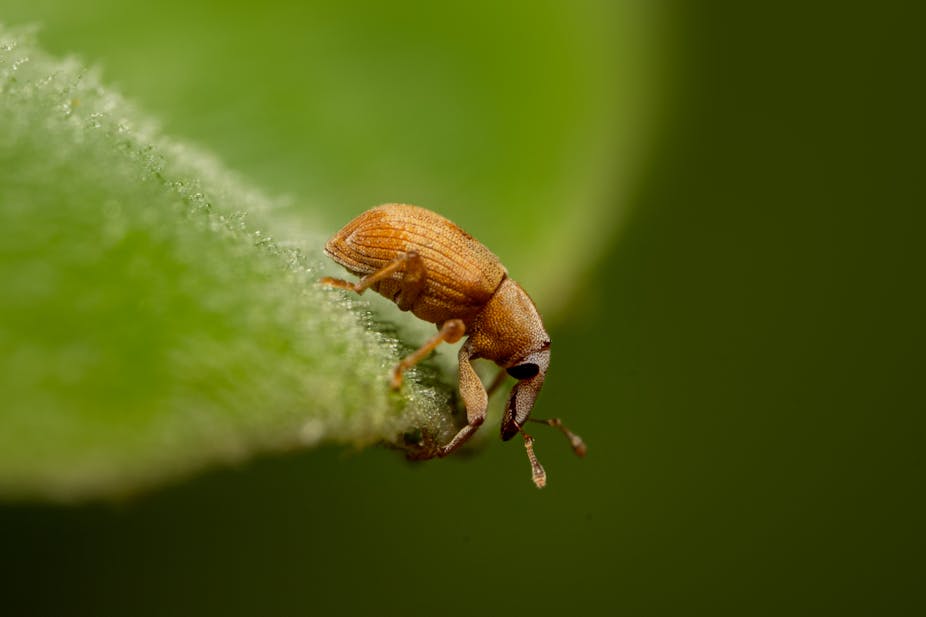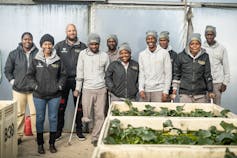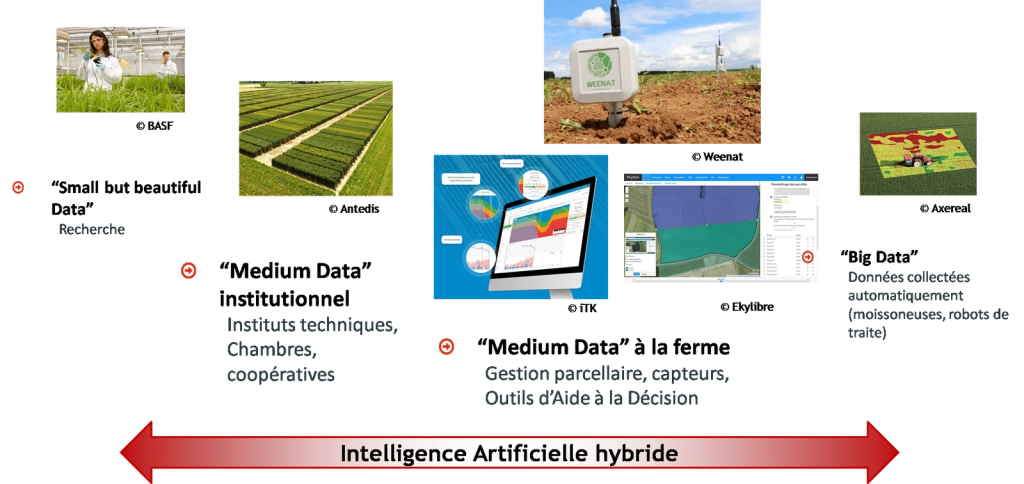The value of “connected agriculture” in making life easier for farmers, and helping them reduce the environmental impact of their practices, is no longer unproven. Another of its advantages is beginning to emerge: by producing large amounts of data of near- research quality, it helps align agronomic and zootechnical research closer to farmers’ requirements, and could better inform agricultural public policies.Digital agriculture is a concept which is beginning to reach grass-roots level, as the high visibility of the subject at the Paris Agriculture Fair demonstrated. In the gloomy atmosphere generated by the feeling of “agri-bashing” experienced by many farmers, it was one of the few subjects that gave a positive and attractive picture of recent developments in agriculture.
Digital farming tools were first designed to make life easier for farmers (GPS guidance, herd monitoring sensors), and to help them optimise their farming practices on an environmental level (connected weather stations, crop models used to optimise input usage). They have also strengthened ties with the consumer, who, thanks to the development of traceability and social networks, can now put a face and a name to the food he buys.
More behind the scenes, connected agriculture is also beginning to have a new beneficial effect, which could in future play an even more positive role for the agricultural world: bringing farmers closer to the research world… and as a result to the policy makers who make use of it.
When science has to be done at the farm level
This development is already a reality in some areas of R & D in digital agriculture. To take the example of herd monitoring sensors: they were first developed to detect unusual and clearly identified events, such as detecting temperatures or calving. These initial applications were developed in a conventional research setting, top down from the lab to the field: algorithms for event detection were developed in tests in experimental farms at research or technical institutes, then tested on a small range of farms before being launched commercially.
As these initial applications have reached maturity, research is now focused on analyses of the daily behaviour and welfare of animals: for example, measuring time spent standing or lying, feeding and rumination times. In these areas it is important to detect more subtle changes in the “daily life” of animals, compared to their ordinary activity.
That makes it very difficult to develop this type of algorithm on experimental farms, where the usual activities of livestock (milking, being put out to pasture, etc.) are frequently disturbed by experiments that modify their usual behaviour, and generate movements or immobility that would not happen in a commercial farm. This type of work should therefore be carried out directly in the field, with experiments in controlled conditions being used only as spot checks in a minority of situations. This is an example of an inversion of the classic relationship between scientific experimentation and field data.
From the lab to the vineyard… and back!
Another example of linking research to farmers’ concerns is the use of mechanistic crop models in decision support tools. These models, derived from agronomic research, are increasingly being used for yield forecasting and management of the required inputs (irrigation, fertilisation). Similar epidemiological models are also used to predict the occurrence of diseases or pests threatening crops, in order to position pesticide treatments most accurately.
By design, the result of extensive research in ecophysiology, these models are sufficiently robust and predictive to lend themselves to plausible simulations on the potential effect of changing practices for agro-ecological reasons, or to adapt to climate change. They also have the advantage of objectively quantifying the environmental conditions to which crops are exposed.
Evapotranspiration is a classic example of a simple indicator for measuring crop water demand, which can then be used as a benchmark to check whether irrigation by the farmer has avoided water waste. However, it remains a relatively basic indicator, which is relevant only in the simplest cases: those where we are only seeking to maintain the yield potential by avoiding water deficit for the crop. For some produce, irrigation issues are more complex, because a small, well-controlled water deficit improves the quality of production: the best known case being vines, where the ideal method, defined by the specifications of the wine appellation, aims to create a moderate water deficit during the maturation of the grape, with varying degrees of severity depending on the type of wine you want to produce.
In this case, irrigation management requires much more complex models than a simple evapotranspiration calculation, and they will use not only climate data, but also soil characteristics and the volume of vegetation in the vineyard. At first glance this is once again a top-down approach to the maximisation of research value, from the laboratory to the field. But the use of these models on farms then permits valuable feedback, which will bring the theoretical work closer to the practice of farmers or their consultants.
The Vintel software, developed by iTK in partnership with (among others) INRA and CIRAD, offers a good example of these two-way exchanges between lab and field. Designed to optimise precision irrigation on vines, it is based on a model derived from research work, based on a classic indicator in research of conventional water stress, the basic leaf water potential.
This indicator is the most reliable for measuring the moisture condition of a vine plant, but its measurement is fiddly, which limits its use in vineyards: it has to be measured at dawn with a specific instrument, the pressure chamber. Some wine consultants, particularly in California, use pressure chambers to advise winegrowers. However, they use these measures at noon for convenience, but also to better understand the water deficit of the plot at the time of the day when it is at its height.
This way of measuring is much less common in research, and so originally it was impossible to develop a mechanistic model to simulate it. Vintel was initially released with a model which only estimated the basic leaf water potential. A few years of use of this first version, by consultants expert in the use of the midday potential measurement, then allowed the development of a second model for midday leaf water potential, combining meteorological data and indicators from the base potential, without going through the laboratory process again.
This example clearly demonstrates the new complementarity between research and digital tools for farmers: it is obviously the data from the field that made it possible to develop a model of midday leaf water potential, in line with the habits of winegrower technicians. But that alone would not have been enough to develop a reliable statistical model: only combining them with indicators from a mechanistic model derived from research could lead to the development of a model robust enough to be entrusted to winegrowers and consultants.
“Medium Data” vs Big Data
A few years ago, the explosion of Big Data technologies, and their introduction into the agricultural world, gave rise to a rather binary view split between two scientific approaches:
- On the one hand, the classic approach of agronomic or zootechnical research, relying on high-quality but relatively sparse experiments, to develop predictive models that can be used in decision support, based on the human expertise of researchers,
- On the other hand, the new data-centred Big Data approaches applying machine learning techniques (machine learning, deep learning) to massive volumes of data from new sensors deployed in agriculture (combine yield sensors, data collected by milking robots),
The enthusiasm for Big Data was based on the assumption that deep learning would allow the development of reliable predictive models, despite the “noise” generated by the information from the masses of data collected, which exceed what human expertise is capable of analysing. In fact, this hope quickly came up against the major pitfall of machine learning techniques: their lack of user-friendliness…both for end users (farmers or breeders), and service designers! Machine learning certainly now makes it possible to define seemingly satisfactory decision rules or models from any sufficiently large dataset.
But without knowing the “reasoning” underlying these models, even their designers are unable to predict to what extent these rules or models can be used in new contexts: a rather distressing uncertainty when developing new agricultural services beyond the region where they were initially proven, or in new climate situations.
In addition to its sensitivity to unpredictable climate risks, agriculture has another unfortunate feature for machine learning: the real data that can be accumulated on the ground is far from covering all possible combinations of cultivation techniques. The technical strategies used by farmers are influenced by their habits, experience and the expertise of their consultants, and are therefore absolutely implicitly limited by human rationales. The situation is in this regard completely different from areas such as machine learning applied to games such as chess or go: in the latter case, the algorithm is able, based on the rules of the game, to test all possible and imaginable combinations, even those that a human expert would not think of. In agriculture, artificial intelligence is hampered by the fact that the available data is the result of human reasoning, which prevents it from finding original “solutions” to invent new practices.
The result of these constraints is that purely data-driven approaches are struggling to make a decisive breakthrough in agricultural decision support. The future is undoubtedly, as we have seen from Vintel’s example, the combination of data-driven approaches and mechanistic models to integrate human expertise into Artificial Intelligence. This new vision, hybrid AI, has been chosen as one of the major themes of ANITI, the new Institute of Artificial Intelligence currently being created in Toulouse… and agriculture has been identified as one of its priority areas of application.
This close interconnection between scientific expertise and farm data has an obvious corollary: the need to bridge the gap between Big Data and research data. This is the mission of what can be called “Medium Data”: well-founded data from farms, or at least from plots run under conditions similar to those of farms. Until now, this role of producing intermediate data has been entirely devolved to experiments at agricultural development agencies: technical institutes, chambers of agriculture, cooperatives[4]. Digital agriculture will allow for the emergence of a new category of “medium data”: data of near-research quality, but spread across hundreds or thousands of farms.
Between the scientific data of research, high quality but sparse, and the “Big Data” of sensors embedded on agricultural equipment, connected agriculture allows the emergence of a “Medium Data”: data of near-research quality, acquired on farms, and not small, unrepresentative experimental plots. It is this continuum of data that will fuel hybrid artificial intelligence (a combination of machine learning and mechanistic human expertise), one of the most promising avenues in today’s AI.
Information to ground agricultural public policy
We have seen, with the example of irrigation, that agricultural decision support tools lend themselves well to the creation of objective indicators of crop needs: the same approach is easily transferable to fertilisation, as well as crop protection. Epidemiological models, already used to advise optimal treatment dates for diseases and pests, could also be used at plot level to quantify the still vague and subjective idea of “threat of disease” Such indicators would be valuable in improving the monitoring of Ecophyto, the plan to reduce the use of pesticides launched in 2010 following the “Grenelle de l’Environnement” debate.
It’s not overstating the case to say that, almost 10 years after its inception, the plan is far from the 50% reduction target (“if possible”) assigned to it: pesticide consumption shows no significant changes on the national average. Even more disturbing, even the plan’s flagship farms, the Dephy network, are a long way from achieving the expected goal. In view of what can hardly be described other than as a failure, the Académie d’Agriculture de France has recently made recommendations to improve the management of the Ecophyto Plan, including the creation of this kind of indicator of health pressure on crops. Digital agriculture could also play a major role in another of the Academy’s proposals: annual surveys of agricultural practices, the only references that can be used to calculate farmers’ pesticide consumption in any detail.
Indeed, the current indicator for the Ecophyto Plan, NODU, is not suited to an agronomic interpretation, which would allow calculation of the potential reduction in pesticide use at farm level. Another indicator, the TFI, would allow for this calculation, although it is currently calculated only every three years, due to the cost of the surveys currently required to collect the data. This still remains the situation, but plot management software enables the automatic calculation of this indicator for farmers who have the equipment. A representative network of farms equipped with this software would therefore allow the annual TFIs to be calculated at a lower cost and cross-linked with the health pressure indicators mentioned above. It should thus be possible to follow up the Ecophyto plan with greater accuracy… and probably to redefine a more realistic set of goals for it, differentiated by crop and region!
Participatory science, which draws on the knowledge of its future users and civil society stakeholders, is one of the key trends in current research. INRA has also been heavily involved in this area. However, much participatory science work remains very asymmetrical: researchers are often the only players putting forward the theories based on the informal and unorganised knowledge of the stakeholders involved in the project. Connected agriculture offers a unique opportunity for farmers to take ownership of research topics that affect them, producing data for themselves which is as understandable for them as for the researchers who will make use of it. Beyond its impact on the daily work of farmers, it therefore has great potential to bring research closer to their needs and enable politicians to better understand their practices. This is how agriculture will be able to meet society’s many expectations of it.
www.europeanscientist.com
 We believe in the free flow of information
We believe in the free flow of information





